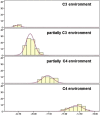Does the rattle of Crotalus durissus terrificus reveal its dietary history?
- PMID: 25540653
- PMCID: PMC4276105
- DOI: 10.1186/1678-9199-20-53
Does the rattle of Crotalus durissus terrificus reveal its dietary history?
Abstract
Background: Environmental devastation threatens the survival of many species, including venomous snakes such as the South American rattlesnake Crotalus durissus terrificus. This observation is based on the decrease of snakes collected and donated to Brazilian research institutes. Nevertheless, some individuals have managed to survive and procreate. The question is how these snakes are adapting in these new environmental conditions.
Methods: To answer it, the carbon-13 level of rattlesnakes and their feed (either laboratory or wild mice) was evaluated by isotope-ratio mass spectrometry. Thus, rattle segments from 16 adults and 15 offspring of captive snakes, and of three wild newborn C. d. terrificus were evaluated as well as 17 Mus musculus mice captured in traps, four live feeder mice and the ration offered to mice at animal houses.
Results: The isotopic exchange time of the captive adult snakes (n = 16) varied between 33 and 37 months and of captive-born animals (n = 15), until reaching a plateau of equilibrium, varied from 18 to 24 months. Regarding the captured Mus musculus (n = 17), 88.23% (n = 15) were from a C4 environment. Of the six rattle rings from offspring of captured C. d. terrificus, five were from a C4 environment, whereas of the 170 rattle rings studied, 60% originated from a C3 environment and 40% from a C4. The same carbon-13 values were found in captive snakes.
Conclusions: Based on the present results, it can be inferred that most C. d. terrificus snakes (60%) fed animals from a C3 environment; birds consist of an alimentary alternative for snakes, as well as rodents, small reptiles and amphibians; different venom compositions among snakes from the same region may be related to the food type; the primary rattle of offspring reflects the maternal diet during gestation; and, finally, the different rattle rings indicate the alimentary history of these animals.
Keywords: Carbon-13; Crotalus durissus terrificus; Food; Stable isotopes.
Figures








References
-
- Barraviera B, Bonjorno JC, Jr, Arakaki D, Domingues MA, Pereira PC, Mendes RP, Machado JM, Meira DA. A retrospective study of 40 victims of Crotalus snake bites. Analysis of the hepatic necrosis observed in one patient. Rev Soc Bras Med Trop. 1989;22(1):5–12. doi: 10.1590/S0037-86821989000100002. - DOI - PubMed
-
- Azevedo-Marques MM, Cupo P, Hering SE. Acidentes por animais peçonhentos. Medicina, Ribeirão Preto. 1992;25:539–554.
-
- Sgarbi LPS, Ilias M, Machado T, Alvarez L, Barraviera B. Human envenomations due to snakebites in Marília, state of São Paulo, Brazil. A retrospective epidemiological study. J Venom Anim Toxins. 1995;1(2):70–78. doi: 10.1590/S0104-79301995000200004. - DOI
-
- Mizutani H, Kubaya Y, Wada E. Nitrogen and carbon isotope compositions relate linearly in cormorants tissues and its diets. Isot Environ Health Stud. 1991;27(4):166–168. doi: 10.1080/10256019108622500. - DOI
LinkOut - more resources
Full Text Sources
Other Literature Sources
Miscellaneous

